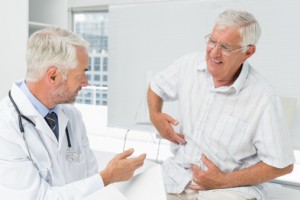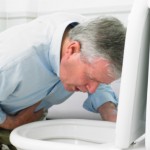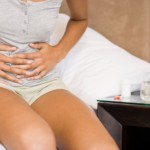Appendicitis (inflamed appendix), abdominal pain, causes, symptoms and treatment
 Appendicitis is inflammation of the appendix and can lead to severe abdominal pain. The appendix is a tube of tissue that extends from the large intestine.
Appendicitis is inflammation of the appendix and can lead to severe abdominal pain. The appendix is a tube of tissue that extends from the large intestine.
Although many do not know what the function of the appendix is, we do know that we can live without it. Therefore, we know that if we develops appendicitis, removing it is safe and won’t hinder our health.
Although we may not need the appendix, when the appendix becomes inflamed it is a serious condition that requires emergency surgery.
If untreated the appendix can burst, which can send toxins into the body and abdomen. If this occurs it can lead to peritonitis – inflammation of the abdominal cavity.
Symptoms and causes of appendicitis
Appendicitis is caused when a blockage occurs in the appendix, usually produced by stool, a foreign body or cancer. Infection, too, can contribute to blockages in the appendix because the appendix can swell and become inflamed with the presence of an infection.
More specific causes of appendicitis include:

- Gallstones
- Ectopic pregnancy
- Ovarian cysts
- Irritable bowel syndrome
- Urinary tract infection
- Crohn’s disease
- Indigestion
- Gas
- Peptic ulcers
- Kidney infection
- Lactose intolerance
- Food allergies
- Constipation
- Hernia
Symptoms of appendicitis include:
- Dull pain near the navel or upper abdomen, which can become sharp or move to the lower right abdomen
- Loss of appetite
- Nausea or vomiting
- Abdominal pain and swelling
- Fever
- Inability to pass gas
- Dull or sharp pain anywhere in the upper or lower abdomen, back or rectum
- Painful urination
- Severe cramps
- Constipation or diarrhea
Abdominal pain and appendicitis
To determine if you have appendicitis or another condition, you need to be able to recognize the type of abdominal pain felt in appendicitis, so you will know the difference.
Appendicitis abdominal pain begins as dull pain around the belly button but can move to the right lower abdomen closer to your appendix. Appendicitis pain can also:
 Begin suddenly
Begin suddenly- Become sharper over time
- Be the first symptom prior to any other symptom associated with appendicitis
- Get worse through movement, breathing, coughing or sneezing
- Make it painful to touch your abdomen
- Hurt when someone applies pressure on your knee and you attempt to lift it while lying on your back
- Display as pain in your abdomen when you move with your right knee bent to the left while lying on your back
Treatment and diagnosis of appendicitis
Appendicitis is diagnosed by tenderness in the lower right part of the abdomen, along with other tests that your doctor will perform. Diagnostic testing for appendicitis includes:
- Urinalysis
- Pelvic exam
- Pregnancy test – to rule out ectopic pregnancy
- Abdominal imaging
- Chest x-ray – to rule out lower lobe pneumonia

Depending on the severity of the appendicitis, surgery may not be required. Instead, antibiotics and fluids may be the course of treatment. Generally, though, because we do not require our appendix, surgery is performed to remove it.
Surgery can either be open or laparoscopy, which is less invasive. In laparoscopy surgery recovery time is quicker.
Study shows surgery may not be essential for uncomplicated appendicitis
Due to the fact that we don’t need our appendix, it is more common to surgically remove it; however, research has shown that in uncomplicated appendicitis surgery may not be necessary. The study randomly assigned antibiotics treatment to patients with appendicitis and found that at the one year follow-up period the patients did not require surgery, and those who received the surgery did not experience significant complications. But when the two treatment methods were compared, antibiotic treatment did not prove to be better than traditional treatment methods.
The authors wrote, “To our knowledge, the APPAC trial is the largest multicenter, open-label, noninferiority [randomized controlled trial] of antibiotic treatment for appendicitis conducted to date. When the trial was designed, we assumed that there would be sufficient benefits from avoiding surgery and that a 24 percent failure rate in the antibiotic group would be acceptable. Instead, we found a failure rate of 27.3 percent (95 percent confidence interval, 22.0-33.2 percent) and were not able to establish the noninferiority of antibiotic treatment for appendicitis.”
The researchers found that 72.7 percent of patients with uncomplicated appendicitis recovered solely from the antibiotics treatment. Those in the antibiotics group had longer hospital stays, but the researchers point out in the future this length of time could be shortened.
The authors also note the importance of CT imaging in diagnosing appendicitis to truly know which treatment methods should be utilized. CT scans can clarify the severity of appendicitis, helping doctors choose a course of treatment. The authors wrote, “Another feature of our study was the low negative appendectomy rate attributable to CT imaging. Use of CT also enabled us to identify uncomplicated acute appendicitis that was successfully treated with antibiotics alone in the majority of patients enrolled in our study.”
Home remedies for appendicitis
Although appendicitis does require immediate medical attention, there are important things to note about recovery and when the symptoms first arise.
- Don’t perform strenuous activity.
- Support your abdomen when you cough.
- If pain medications are not working call your doctor.
- Increase movement slowly.
- When tired, sleep.
- Castor oil can help reduce inflammation.
- Consume garlic, which can reduce inflammation and fight infection.
- Increase fiber intake to avoid constipation, which can contribute to appendicitis and lead to further pain.
Your doctor will help you make a recovery plan after treatment has been conducted. Although you may be sore for a few days, non-invasive surgery recovery time is much shorter, which means you can get back to the things you enjoy.
Do these 4 things at night for a healthier stomach
The bloating, the gas, the discomfort – it’s enough to make you dread putting on pants and leaving the house. The thing about stomach problems is that you’re often not sure what caused them. Continue reading…
-
How Well The Suddenly Slim Diet Works
The Suddenly Slim diet program is an herbal weight loss program tha
-
Stop Overeating Now 10 Simple Strategies
Do you find yourself struggling to stay on track with your eating and
-
The Hollywood Diet Benefits
The Hollywood diet plan or fruit diet pl
-
Use Common Sense & Eat A Balanced Diet For Weight Loss
Just like anything else in life, starting your weight loss journ
-
Diseases Caused By Obesity
Everyone knows the drastic extend of the obesity epidemic today,
-
10 Types of Hunger and How to Control Them
V
- DON'T MISS
- An Exercise Weight Loss Plan For The Busy Bee
- Lose Two Pounds Per Week: Four Diet Tips
- How Men & Women Burn Fat Differently + What To Do For Your Body
- Fighting Stress and Losing Weight With Cortislim Weight Loss Product?
- Do I Need to Lose Weight?
- 5 Weight Loss Tips You Can Use
- Eat Fried Foods, Lose Weight & Feel Great
- Low Carb Foods Dieting Boon Or Ripoff
- Lose Weight Today - 6 Things You Need To Know To Get Started
- Avoid Weight Gain over the Weekend




